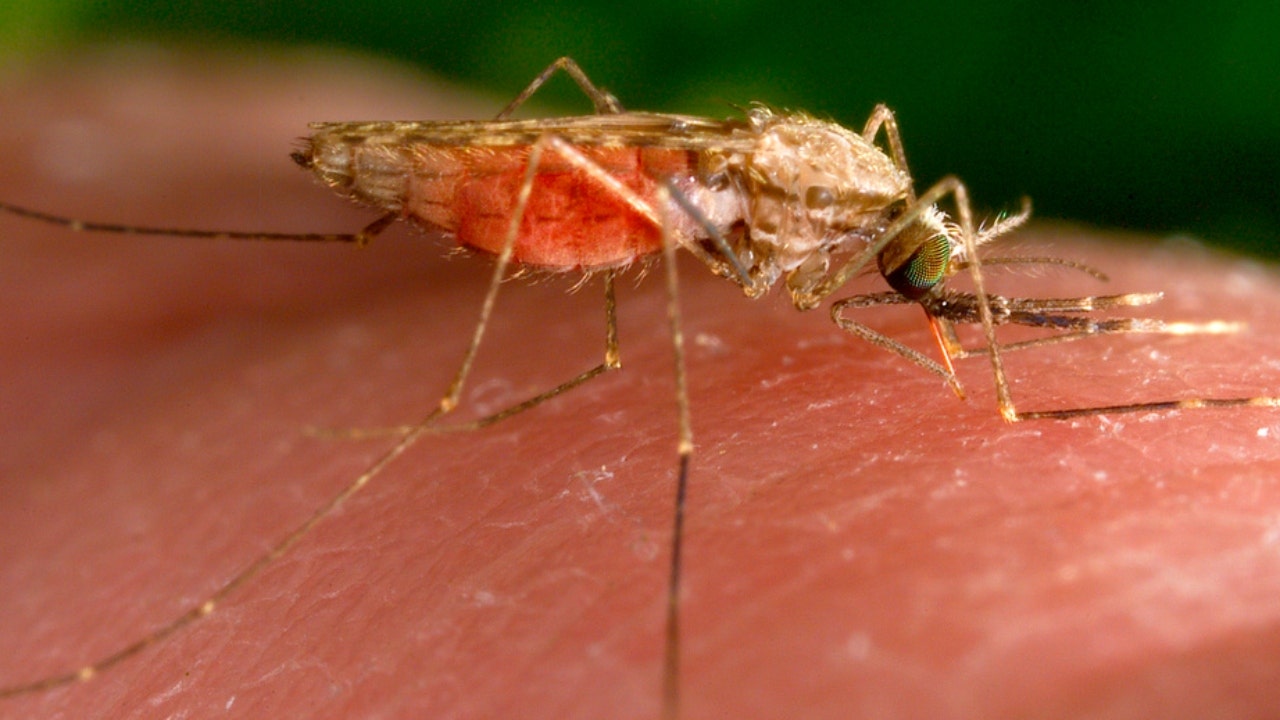Health
First US malaria cases diagnosed in decades: What to know about the disease

The first malaria cases in decades were recently confirmed in two southern states.
Four cases were confirmed in Florida, and one was reported in Texas. All patients have received treatment and are improving.
There is no evidence to suggest the cases in the two states, confirmed within the past two months, are related.
The Florida Department of Health has issued a statewide mosquito-borne illness advisory following the cases along the Gulf Coast of south Tampa.
LOCALLY ACQUIRED MALARIA CASES CONFIRMED IN TEXAS AND FLORIDA AS CDC CALLS FOR ACTION PLAN
This 2014 photo made available by the U.S. Centers for Disease Control and Prevention shows a feeding female Anopheles gambiae mosquito. The species is a known vector for the parasitic disease malaria. The United States has seen five cases of malaria spread by mosquitos in the last two months; the first time there has been local spread in 20 years. There were four cases detected in Florida and one in Texas, according to a health alert issued Monday, June 26, 2023, by the CDC. (James Gathany/CDC via AP)
Surveillance for additional cases is ongoing, according to the Centers for Disease Control and Prevention.
The agency said locally acquired mosquito-borne malaria has not occurred in the U.S. since 2003, when eight cases of locally acquired Plasmodium vivax malaria were identified in Palm Beach County, Florida.
It noted that, despite recently-confirmed cases, the risk of locally acquired malaria remains extremely low.
Here is what to know to stay healthy.
What is malaria?
Malaria is a potentially fatal disease that is transmitted through the bite of an infective female Anopheles mosquito and caused by a parasite. Most of the continental U.S. has Anopheles mosquitoes.
However, in rare cases, it can also be transmitted congenitally from mother to fetus at birth, as well as through blood transfusion, organ transplantation or unsafe needle-sharing practices.
How do mosquitoes transmit malaria?
Malaria is caused by any of these five species: Plasmodium: P. falciparum, P. vivax, P. malariae, P. ovale and P. knowlesi.
Approximately 2,000 cases of malaria are diagnosed in the country each year, and the majority of U.S. cases are in travelers and immigrants returning from countries where malaria transmission occurs – many from sub-Saharan Africa and South Asia.
Around 300 people experienced severe disease, and 5 to 10 people with malaria died yearly before the COVID-19 pandemic.
Local U.S. mosquito-borne spread has resulted in more than 150 locally acquired cases and more than 60 limited outbreaks over the past 50 years.
WEST NILE VIRUS CASES, POSITIVE SAMPLES DETECTED ACROSS THE COUNTRY

A handbook is seen at Florida Keys Mosquito Control District headquarters, in Marathon, Florida, U.S. May 4, 2021. (REUTERS/Marco Bello/File Photo)
How many cases occur annually around the world?
Globally, more than 240 million cases of malaria occur each year, with 95% in Africa.
Most imported cases of malaria in the U.S. are diagnosed during summer and early fall.
Where is the risk higher?
The risk for malaria is higher in areas where local climatic conditions allow the Anopheles mosquito to survive during most of or the entire year, as well as where travelers from malaria-endemic areas are found.
What are the symptoms?
Clinical manifestations of malaria include fever, chills, headache, myalgias and fatigue.
Nausea, vomiting and diarrhea may also occur.
For most people, symptoms star 10 days to four weeks after infection, although a person may feel ill as early as a week after infection or as late as a full year after infection.

A mosquito, or Culicidae, is caught in a plastic box in the eastern German town of Leipzig July 10, 2013. (REUTERS/Tobias Schwarz//File Photo)
What is the treatment?
Malaria may progress to severe disease if not treated properly, during which seizures, renal failure, a change of mental status, acute respiratory distress syndrome and coma may occur.
Malaria in pregnant people is associated with high risks of both maternal and perinatal morbidity and mortality.
Patients suspected of having malaria should be urgently evaluated in a facility that is able to provide rapid diagnosis and treatment within 24 hours of presentation.
There are drugs to treat non-severe malaria and intravenous artesunate is the only medication available in the U.S. for severe cases.
The Associated Press contributed to this report.

Health
Semaglutide Pills and Injections Vs. Drops: Experts Weigh In | Woman's World

Sign Up
Create a free account to access exclusive content, play games, solve puzzles, test your pop-culture knowledge and receive special offers.
Already have an account? Login
Use left and right arrow keys to navigate between menu items.
Use escape to exit the menu.
Health
Jennifer Hudson Lost 80-Lbs Without Depriving Herself—Learn Her Secrets

Sign Up
Create a free account to access exclusive content, play games, solve puzzles, test your pop-culture knowledge and receive special offers.
Already have an account? Login
Use left and right arrow keys to navigate between menu items.
Use escape to exit the menu.
Health
Kennedy’s Plan for the Drug Crisis: A Network of ‘Healing Farms’

Though Mr. Kennedy’s embrace of recovery farms may be novel, the concept stretches back almost a century. In 1935, the government opened the United States Narcotic Farm in Lexington, Ky., to research and treat addiction. Over the years, residents included Chet Baker and William S. Burroughs (who portrayed the institution in his novel, “Junkie: Confessions of an Unredeemed Drug Addict”). The program had high relapse rates and was tainted by drug experiments on human subjects. By 1975, as local treatment centers began to proliferate around the country, the program closed.
In America, therapeutic communities for addiction treatment became popular in the 1960s and ’70s. Some, like Synanon, became notorious for cultlike, abusive environments. There are now perhaps 3,000 worldwide, researchers estimate, including one that Mr. Kennedy has also praised — San Patrignano, an Italian program whose centerpiece is a highly regarded bakery, staffed by residents.
“If we do go down the road of large government-funded therapeutic communities, I’d want to see some oversight to ensure they live up to modern standards,” said Dr. Sabet, who is now president of the Foundation for Drug Policy Solutions. “We should get rid of the false dichotomy, too, between these approaches and medications, since we know they can work together for some people.”
Should Mr. Kennedy be confirmed, his authority to establish healing farms would be uncertain. Building federal treatment farms in “depressed rural areas,” as he said in his documentary, presumably on public land, would hit political and legal roadblocks. Fully legalizing and taxing cannabis to pay for the farms would require congressional action.
In the concluding moments of the documentary, Mr. Kennedy invoked Carl Jung, the Swiss psychiatrist whose views on spirituality influenced Alcoholics Anonymous. Dr. Jung, he said, felt that “people who believed in God got better faster and that their recovery was more durable and enduring than people who didn’t.”
-
/cdn.vox-cdn.com/uploads/chorus_asset/file/25822586/STK169_ZUCKERBERG_MAGA_STKS491_CVIRGINIA_A.jpg)
/cdn.vox-cdn.com/uploads/chorus_asset/file/25822586/STK169_ZUCKERBERG_MAGA_STKS491_CVIRGINIA_A.jpg) Technology1 week ago
Technology1 week agoMeta is highlighting a splintering global approach to online speech
-

 Science1 week ago
Science1 week agoMetro will offer free rides in L.A. through Sunday due to fires
-
/cdn.vox-cdn.com/uploads/chorus_asset/file/23935558/acastro_STK103__01.jpg)
/cdn.vox-cdn.com/uploads/chorus_asset/file/23935558/acastro_STK103__01.jpg) Technology1 week ago
Technology1 week agoAmazon Prime will shut down its clothing try-on program
-

 News1 week ago
News1 week agoMapping the Damage From the Palisades Fire
-
/cdn.vox-cdn.com/uploads/chorus_asset/file/25826211/lorealcellbioprint.jpg)
/cdn.vox-cdn.com/uploads/chorus_asset/file/25826211/lorealcellbioprint.jpg) Technology7 days ago
Technology7 days agoL’Oréal’s new skincare gadget told me I should try retinol
-
/cdn.vox-cdn.com/uploads/chorus_asset/file/25832751/2192581677.jpg)
/cdn.vox-cdn.com/uploads/chorus_asset/file/25832751/2192581677.jpg) Technology4 days ago
Technology4 days agoSuper Bowl LIX will stream for free on Tubi
-

 Business5 days ago
Business5 days agoWhy TikTok Users Are Downloading ‘Red Note,’ the Chinese App
-
/cdn.vox-cdn.com/uploads/chorus_asset/file/25835602/Switch_DonkeyKongCountryReturnsHD_scrn_19.png)
/cdn.vox-cdn.com/uploads/chorus_asset/file/25835602/Switch_DonkeyKongCountryReturnsHD_scrn_19.png) Technology2 days ago
Technology2 days agoNintendo omits original Donkey Kong Country Returns team from the remaster’s credits


















